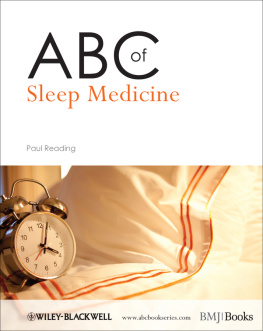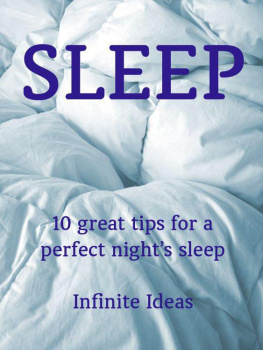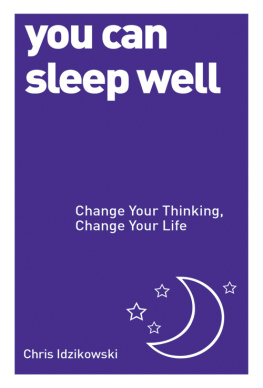ACKNOWLEDGEMENTS
I want to thank all of the people in my life who made the writing of this book possible:
To all of my patients and clients over the years who have truly brought the theory to life for me.
To Louise Orpin for spinning her magical spider web. Kerry-Lyn Stanton-Downes for her support and ideas. Dr Andrew Norman for the clever introduction. Shona Hood for critique, listening skills and babysitting. Lisa Lewisohn for encouragement and taking a huge load off my shoulders. To all of my friends for kind words and positive energy. To all at Souvenir Press, especially Ernest Hecht for taking a punt and Lara Mathers for her calm guidance.
A special thank you to Andrew Kwok who made it safe for me to not sleep.
To my wonderful parents without whom this would never have been possible. You have given me the vital ingredients that have kept me (relatively) balanced and made me who I am.
Finally, to my little family, Peter and Maya. Peter, youve been my partner in this every step of the way. I thank you for your patience and belief and for enduring yet another of my obsessions. Maya Nirvana, as always, my inspiration and lucky star. You are an incredible little being. Thank you for understanding when I have had no choice but to hibernate and write.
CHAPTER 1
Sleep in a Changing World
How did you sleep last night?
Did you slide effortlessly into a cocoon of thick, velvety sleep? Did you awaken filled with energy and enthusiasm, looking forward to the day ahead?
Or did you crash out exhausted and then find you just couldnt sleep?
Are you Tired but Wired?
This book is about helping you to get brilliant sleep and by this I mean sleep that is deep, nourishing, refreshing and peaceful sleep that is the opposite of Tired but Wired. I firmly believe that our physiology is actually designed to give us this type of sleep. In other words:
Your physiology is designed to give you brilliant sleep.
You may not believe this if you havent slept well for a while and, in fact, you may even have forgotten what good sleep feels like. But somewhere along the line, something has disrupted the natural process of your sleep and brilliant sleep is for you either a distant memory or something you have never had.
How can something that is so natural, so innate and actually hardwired into our physiology go so wrong for some of us? There are many factors that can disrupt sleep and you will learn more about this as you read further. But I believe that there is something about our 21st Century world that has had a particularly significant impact on our sleep and the ability to renew our energy.
Faster and Faster
At the time of writing, Ive never been busier juggling writing, professional commitments, time for my family and friends, time to look after myself and time to sleep. But Im not alone in this everywhere I go I see the same pressurised busyness and go, go, go!
The world we are living in is going faster and faster driven by technology and globalisation. We struggle to keep up and find ourselves reaching for caffeine, energy drinks, anything that will help us to fuel the manic need to do more and in less time. For many of us in the Western world our days are relentlessly linear, we rarely go offline. The word downtime, originally used to describe the cessation of operations in a manufacturing or engineering environment, is now used to describe the guilt-ridden periods of rest that increasingly we have less time for. At night we retire to bed desperate for some rest and then find we just cant relax, we just cant stop and be.
I began using the phrase Tired But Wired firstly to describe my own sleep and then that of my clients and patients. For many years, I went to bed with crazy snippets of conversations Id had throughout the day, music Id listened to and random to-do lists, all playing at extra loud volume in my brain. It was driving me mad and stopping me from sleeping even if I was exhausted. I never questioned it. It was just me, wasnt it? And then I started working in a clinic and seeing stressed out bankers, teachers, lawyers, over-stretched mothers, and even anxious school children and noticed that they would describe the same noise to me.
At the same time, the pace of technology had taken off and everyone seemed to be grappling with the same challenges of information overload, and trying to fit even more into their lives. It seemed the treadmill had stepped up a few notches and this played havoc with my clients energy levels and, in particular, sleep. When I used the phrase Tired but Wired I would see an immediate look of comprehension and relief on their faces. At last! Someone who understands.
Technology Friend or Foe?
Dont get me wrong Im definitely not a technophobe. I love the fact that I can press a few buttons and in the blink of an eye, my parents who are thousands of miles away will see the most recent image of their 5yr old granddaughter. I love the fact that browsing the Internet has saved me hours of precious time that would have been spent getting to a library and then finding the material that I needed to write this book. Im amazed by the fact that in realtime using Webcasts and Webinars, I can get my message out to thousands of people living in a different time zone. Technology is amazing!
But Im also sadly aware that something is slipping away from us... In this millennium we increasingly see relationships that are managed by text messages or in chatrooms, school children who have forgotten the art of reading or creating their own stories as they lift paragraphs of easily accessible homework from the Internet. We hear about more and more problems that have arisen as a result of using, or rather abusing, technology. At the hospital we see young people suffering from technology addiction, people complaining of loneliness because of the lack of real human connection, and people suffering from Tired but Wired and insomnia.
The fundamental flaw in all of this is that we as human beings havent quite caught up with technology. As James Gleick says in his book Faster, we are reaching the biological, psychological and neurological limits of just how much we are capable of doing.
The Pulse of Life
Human beings are not meant to be relentlessly linear we are meant to oscillate moving rhythmically between energy expenditure (work) and energy renewal (recovery and renewal). In the 19th Century Claude Bernard was the physiologist who was responsible for a major breakthrough in the understanding of how living organisms remain in a state of balance and equilibrium despite fluctuations in our external environment. He called this homeostasis , which is described as the maintenance of a constant internal environment that is essential for survival. What this means is that living organisms make small internal adjustments oscillations to maintain an internal state of balance and equilibrium. For example, in response to eating a piece of delicious chocolate your blood sugar rises. To stop the level of sugar in the blood from reaching critical limits (and damaging the brain), the pancreas produces insulin that carries the sugar away for storage thus causing a fall in blood sugar. So the rise in the sugar level in the blood triggers reactions that then cause a subsequent fall. Thus your blood sugar hovers around an equilibrium point. This oscillation process is vital for your health and when it stops working normally for example in diabetes you become ill.
Many years ago, I noticed that whenever I talked to my clients or students about the control of body temperature, stress, appetite, breathing, in fact, any physiological process, I would draw an oscillating curve that went up and then down. I went on to use this as a symbol for my business Equilibrium Solutions as I began to realise that every technique I taught was focused on creating balance or a constant internal state. I also noticed that the oscillating line was particularly relevant to sleep.









